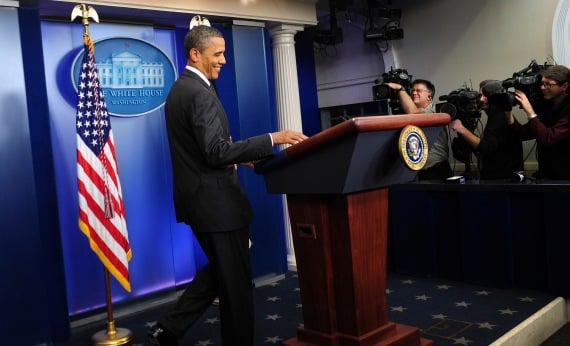In President Barack Obama's tax policy, $250,000 means $250,000 -- except when it means $247,450 or $267,500.
Obama's simple 2008 campaign pledge to prevent tax increases for all but the highest earners has been transformed into tax-code arcana. The dividing line in his speeches - -$250,000 a year for married couples and $200,000 for individuals -- is established in his policies with four separate definitions and three different numbers.
President Obama's dividing line between the fewer than 2 percent of taxpayers who would face tax increases starting in 2013 and the rest who wouldn't was central to his campaign in 2008 and has recurred in his proposals as president.
“It's much more complicated than it sounds,” said Nick Kasprak, an analyst at the Tax Foundation, a Washington group that favors a simpler tax code.
The multiple definitions show what happens when a political talking point becomes a tax proposal. Across-the-board income tax cuts first enacted in 2001 and 2003 expire Dec. 31, and Obama wants Congress to continue the breaks for people below the threshold.
Obama's line separating those who would face tax increases -- fewer than 2 percent of U.S. taxpayers -- and the rest who wouldn't was central to his 2008 campaign. As president, he has urged Congress to adopt a similar approach.
Technical proposals from the Treasury Department meet Obama's objectives of preventing tax increases for anyone making less than his thresholds and even for some people who make more money than that. They also make it tougher for taxpayers to figure out in advance what tax breaks they will receive and which they will lose.
RELATED ITEM 10 tax tips every boomer should know »
The administration and Congress thrive on complexity that makes people throw up their hands and write a check for whatever their accountant or tax software says they owe, said Jack Bogdanski, a tax law professor at Lewis & Clark University in Portland, Oregon.
“They can do whatever they want because they know nobody can figure it out any more,” Bogdanski said. “It's all handed over to computer programs.”
The three numbers and four definitions used to set the line for tax increases can be found in the administration's budget plan for fiscal 2013 and the health care law that Obama signed in 2010.
The most significant definition of the $250,000 barrier in Obama's budget separates the top two brackets from the rest. Above that line, taxpayers' wages, business income and dividends would be taxed at 36 percent or 39.6 percent and their capital gains would be taxed at 20 percent.
They also would face limits on deductions and exclusions such as employer-sponsored health insurance and interest on municipal bonds.
Tax Arithmetic
Tax brackets are based on taxable income after deductions and exemptions. Obama's plan starts with $250,000 and subtracts a standard deduction for married couples and two personal exemptions. There is a similar calculation for single people.
The administration decided to set the $250,000 and $200,000 thresholds in 2009 dollars and index them for inflation. In 2013, when Obama wants the tax increase to take effect, the thresholds for taxable income would be $247,450 for married couples and $203,950 for individuals, according to Treasury Department estimates.
Some people could use deductions to stay out of the higher brackets. A married couple with $280,000 in wages wouldn't face any tax rate increase if they paid $15,000 in state taxes and donated $30,000 to charity.
The second definition, also in the budget, sets the threshold for limits on personal exemptions and itemized deductions. The numbers are indexed for inflation and apply to adjusted gross income, a broader measure than taxable income.
Adjusted Gross Income
Under this standard, married couples with adjusted gross incomes exceeding $267,500 would face higher taxes in 2013, as would individuals with adjusted gross incomes of more than $214,000, according to the Treasury Department.
The third and fourth definitions became law as part of the 2010 health-care overhaul.
Starting in 2013, annual wages of more than $250,000 for married couples and $200,000 for individuals will be subject to an additional 0.9 percent tax. That's a different concept of income, because it's based only on wages.
Unearned income, such as capital gains and dividends, will be subject to a 3.8 percent tax for high earners. The tax will apply to those exceeding the $250,000 and $200,000 thresholds, using a modified definition of adjusted gross income. It will be levied only on unearned income that pushes the taxpayer over the threshold.
Not Indexed
Unlike the proposals in the president's budget, the thresholds in the health care law aren't indexed for inflation and will remain at $250,000 and $200,000 unless Congress acts. That means they will capture more money and more taxpayers over time.
Even without the Obama proposals, the tax code is full of varying definitions of income, said Melissa Labant, director of tax advocacy at the American Institute of Certified Public Accountants, a trade group in Washington.
“It increases confusion, frustration and creates a perception that the tax system is unfair,” she said. “You want to know in advance whether or not a particular benefit applies to you, particularly on the business side and the cash-flow side.”
The changes proposed by Obama would come on top of the alternative minimum tax, which already requires many people in the same income group to pay more. The AMT, a parallel tax system, requires taxpayers to calculate their liability twice, once under the regular code and once under a system that denies some deductions and exemptions.
Some of the complexity stems from a desire to have statutory tax rates that seem lower than they really are, Bogdanski said. Obama's plan would return the top income rate to 39.6 percent while limiting deductions and exemptions.
“Own up,” Bogdanski said. “Make it 40. Make it 41. Just tell the truth about what you're doing. The game-playing with giving you deductions and taking them away, it's absurd.”
--Bloomberg News--







